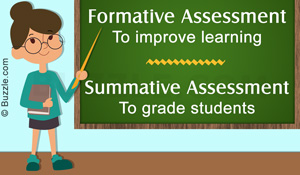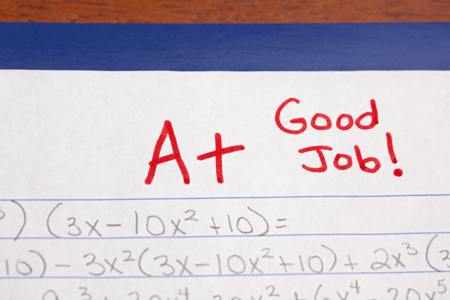

It’s no secret that test anxiety is a common problem in U.S. schools. In fact, it’s so prevalent that the “Stanford 9” exams, used to evaluate schoolchildren, even include instructions for teachers on what to do if a nervous student vomits on their test booklet. But assessment doesn’t always have to be a source of stress for students.
At its core, educational assessment is a tool that helps instructors gather data about the effectiveness of their teaching methods and the extent of their students’ learning. It serves a vital purpose in ensuring that students are making progress and that the curriculum is meeting their needs. However, many people mistakenly believe that assessment always takes the form of a traditional test or exam.
In reality, assessment can take many different forms, from informal classroom discussions to hands-on projects and presentations. The two most common assessment methods are formative assessment and summative assessment. While they share the same ultimate goal of supporting student learning, they differ in their approach, timing, and impact on the learning process. In the following sections, we’ll take a closer look at each of these assessment types and explore how they can be used to promote student growth and achievement.
Article Highlights:
- Formative assessment provides ongoing feedback during the learning process, while summative assessment evaluates learning at the end of an instructional period.
- Formative assessment helps teachers adapt instruction in real-time, while summative assessment informs future course design.
- Formative assessment promotes growth and intrinsic motivation, while summative assessment provides performance benchmarks and extrinsic motivation.
- A balanced approach incorporating both formative and summative assessment is most effective for supporting student learning and informing instructional decisions.
Objective
Formative and summative assessments serve distinct purposes within the educational landscape. Formative assessment is primarily used during the instructional process to monitor student learning and provide ongoing feedback. It’s an evaluation for learning, helping teachers identify areas where students may be struggling and adjust their instruction accordingly. Think of it like a GPS system for educators, providing real-time guidance to keep students on track.
On the other hand, summative assessment is used at the end of an instructional period, such as a unit, semester, or school year, to evaluate student learning. It’s an evaluation of learning, measuring how well students have mastered the material and met the learning objectives. Summative assessments are often higher-stakes than formative assessments, as they may contribute to final grades or determine placement decisions.
Improvement in Teaching
One of the key benefits of formative assessment is that it allows teachers to make real-time adjustments to their instructional methods based on student needs. By gathering data on student understanding throughout the learning process, teachers can identify areas where their approaches may not be as effective as intended and adapt on the fly. This might involve providing additional examples, breaking down complex concepts, or trying out new strategies to support individual learners.
In contrast, summative assessment typically happens too late in the learning process to influence the current instruction. However, the insights gained from summative assessments can still be invaluable for informing future course design. By analyzing patterns in student performance, teachers can pinpoint areas of the curriculum that may need to be reinforced or restructured in subsequent iterations of the course.

Orientation
Formative assessment is all about growth and development. It’s oriented towards helping students and teachers identify areas for improvement and working collaboratively to address any learning challenges. By providing regular feedback and opportunities for reflection, formative assessment encourages students to take ownership of their learning and develop a growth mindset. It’s a partnership between teacher and student, focused on continuous progress.
Summative assessment, on the other hand, is more outcome-oriented. It’s focused on evaluating student performance against a set of predetermined standards or benchmarks. While this information can be valuable for measuring the overall effectiveness of a course or program, it doesn’t always provide students with the targeted feedback they need to improve their learning in the moment.

Frequency
Another key difference between formative and summative assessment is how often they occur. Formative assessment is an ongoing process that is integrated into daily instruction. It happens frequently, sometimes multiple times within a single lesson. This might take the form of a quick check-in question, a short quiz, or an informal observation of student work. The goal is to maintain a constant pulse on student learning, allowing for timely adjustments and interventions.
Summative assessment, in contrast, is typically conducted at the end of significant instructional periods, such as the end of a unit, semester, or school year. While there may be occasional progress checks along the way, the primary focus is on measuring student learning at the conclusion of a defined learning journey. This gives educators a high-level snapshot of student achievement, but it doesn’t provide the same granular, real-time insights as formative assessment.

Grading
Formative and summative assessments also differ in their approach to grading. Formative assessments are generally low-stakes and non-graded. The emphasis is on providing meaningful feedback to guide student learning, rather than assigning scores or labels. In many cases, formative assessments are purely diagnostic, helping teachers and students identify strengths and areas for growth without the pressure of a formal grade.
Summative assessments, on the other hand, are often high-stakes and graded. They play a significant role in determining student progression through a course or program, and they may be used to evaluate the overall effectiveness of the curriculum. Summative assessment scores are typically reported to various stakeholders, including students, parents, administrators, and even external agencies or institutions.

Student Motivation
The contrasting approaches to grading in formative and summative assessment can have a profound impact on student motivation. Formative assessment, with its emphasis on growth and continuous improvement, tends to cultivate intrinsic motivation. When students receive regular, personalized feedback and support, they’re more likely to develop an authentic desire to learn and challenge themselves. The focus is on mastery and progress, rather than external rewards or punishments.
Summative assessment, in contrast, often relies more heavily on extrinsic motivation. The promise of a good grade or the fear of a poor one can be a potent motivator for some students, particularly those who are performance-oriented. However, this type of motivation can also foster a more transactional view of education, where learning is seen as a means to an end rather than an inherently valuable pursuit.
Feedback
The nature of feedback provided by formative and summative assessments is another key point of distinction. Formative assessment prioritizes qualitative, personalized feedback that students can use to guide their learning journey. This feedback is often detailed and specific, highlighting particular strengths and areas for improvement. For example, a teacher might provide extensive comments on a student’s essay draft, offering suggestions for enhancing the argument, clarifying the structure, or refining the writing style.
On the flip side, summative assessment feedback tends to be more quantitative in nature. Students typically receive grades or numeric scores that provide a general sense of their performance, but may not offer much in the way of detailed, actionable insights. A student who receives an 85% on a final exam might know they did well overall, but they may not have a clear understanding of which specific concepts or skills they need to work on moving forward.
Student Involvement
Formative assessment often positions students as active participants in the learning process. They are encouraged to engage in self-reflection, set personal learning goals, and provide constructive feedback to their peers. This type of student involvement can be incredibly empowering, helping learners develop metacognitive skills and take greater ownership of their academic growth. When students are invited to be partners in the assessment process, they are more likely to view feedback as a valuable tool for improvement rather than a judgment of their abilities.
Summative assessment, on the other hand, often casts students in a more passive role. They are typically on the receiving end of assessment results, with limited opportunities to engage in reflection or dialogue about their learning. The emphasis is more on measuring student performance at a given point in time than on fostering ongoing student agency and engagement.

Examples
Formative assessment can take many different forms, from informal check-ins to structured activities. Some common examples include:
- A teacher circulating the room during group work, listening in on student conversations and offering guidance as needed
- Students using a rubric to provide feedback on each other’s project drafts
- A brief quiz at the end of a lesson to gauge student understanding of key concepts
- Students maintaining a learning log to track their progress and reflect on their challenges and successes
Summative assessment, in contrast, tends to be more formal and comprehensive. Typical examples include:
- A final exam that covers all the material from a semester-long course
- A capstone project or portfolio that demonstrates a student’s cumulative learning over an extended period
- A standardized test used for school accountability or student placement purposes
- An Advanced Placement (AP) exam or SAT Subject Test used in the college admissions process

Advantages and Disadvantages
Like any educational approach, formative and summative assessments have their own unique strengths and limitations.
Formative assessment offers several key advantages:
✔️ It provides a continuous stream of actionable feedback to guide student learning
✔️ It allows teachers to adapt instruction in real-time to meet student needs
✔️ It promotes a growth mindset and intrinsic motivation for learning
✔️ It encourages active student involvement in the learning process
However, formative assessment also has some potential drawbacks:
❌ It can be time-consuming to implement on a frequent basis
❌ It may not always provide a clear, holistic picture of student achievement
❌ It often requires a significant shift in mindset and practice for teachers accustomed to more traditional assessment methods
The summative assessment also has its share of strengths
✔️ It provides a standardized measure of student performance that can be used for accountability and program evaluation
✔️ It can serve as a powerful motivator for some students, encouraging them to put forth their best effort
✔️ It allows for comparisons of student achievement across different classrooms, schools, or districts
But summative assessment is not without its challenges:
❌ It can create high-pressure, high-stakes learning environments that may exacerbate student anxiety
❌ It often lacks the detailed, personalized feedback that students need to guide their learning
❌ It may lead to a narrowing of the curriculum as teachers feel pressure to “teach to the test”
FAQs
- Q: Can formative assessment be graded?
A: While formative assessment can be graded, it is typically low-stakes and focused more on providing feedback for improvement than on assigning scores or grades. - Q: How often should summative assessment be used?
A: Summative assessment is typically used at the end of significant instructional periods, such as the end of a unit, semester, or school year. The frequency may vary depending on the specific learning goals and contexts. - Q: Is one type of assessment inherently better than the other?
A: Both formative and summative assessments have valuable roles to play in education. The most effective approach is to use a balanced combination of both types of assessment, tailored to the specific needs of students and learning goals.
Conclusion
In the complex world of education, there is no one-size-fits-all approach to assessment. Both formative and summative assessments have valuable roles to play in supporting student learning and measuring academic achievement. The key is to strike a balance, leveraging the unique strengths of each approach while mitigating their potential limitations.
Formative assessment, with its emphasis on ongoing feedback and growth, helps create a supportive, responsive learning environment where students feel empowered to take risks and learn from their mistakes. Summative assessment, meanwhile, provides a crucial benchmark of student performance that can inform instructional planning and decision-making at a systemic level.
Ultimately, the most effective assessment strategies are those that prioritize student needs and integrate seamlessly into the learning process. By using formative and summative assessments in tandem, educators can gain a rich, holistic understanding of student progress and tailor their instruction accordingly.
As we move forward in an increasingly complex and rapidly changing educational landscape, it is more important than ever to approach assessment with intentionality, flexibility, and a steadfast commitment to student growth. By embracing the power of both formative and summative assessment, we can create learning experiences that are truly worthy of our students’ boundless potential.











